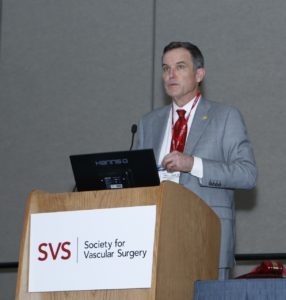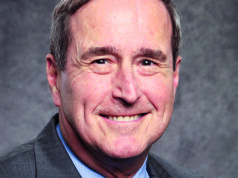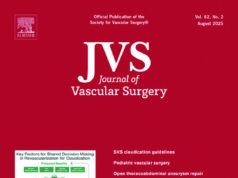
The last nine months took away much. The Vascular Annual Meeting (VAM) was canceled. The Vascular Research Initiatives Conference (VRIC) suffered a similar fate—its content latterly resuscitated in virtual form earlier this month. The traditional Society for Vascular Surgery (SVS) presidential handover, too, followed an unorthodox route.
But if there have been sources of comfort on which to draw despite the challenges posed by COVID-19, for president Ronald L. Dalman, MD, recipient of the SVS baton amid the pandemic, it might be in the coalescence of ongoing SVS work on the identity of vascular surgery and broader cultural currents. This presented an opportunity for SVS introspection and to take a fresh look at what its role as a membership group should be. So much has happened in these months. And much of it has been viewed as positive change. He might be the least traveled SVS president in the history of the Society. Yet, the story of his first six months at the helm might be understood as a narrative of great distance covered.
It kicked off at SVS ONLINE. Dalman announced his presidency in the guise of the E. Stanley Crawford Critical Issues Forum. The intention was clear: Vascular surgery faces existential challenges. So themes of branding, the valuation of vascular surgery and its absence as a standalone specialty in national healthcare league tables took center stage. As 2020 draws to a close, Dalman is starting to see his presidential agenda and longer-term SVS priorities gain traction.
“We’re telling our story: who we are, what our role is in healthcare,” he tells Vascular Specialist. “I mean, we know that, largely. But so many of our colleagues and peers both inside and outside of our profession don’t. And all of this helps to internally validate the sense of belonging and purpose and ambition with our members by pursuing this particular agenda. Oddly enough, even though there is no travel this year—I have to be the least traveled SVS president since the dawn of the jet age—the silver lining in this cloud is it has really helped us focus internally: how the organization can be structured, how we can deliver on our responsibilities to our members, how we make everybody feel as though they have a significant opportunity within SVS to build their career and realize their ambitions. I think it’s actually turned out to be a good opportunity for that because there are so many other things that would traditionally be expected during a presidential year. So that internal focus, that restructuring and extending the promise that we think the SVS holds for all of its members to the entire membership, has been really worthwhile. We hope to optimize this within the next six months.”
Uncertainty
Member practice concerns are front and center. “We have received a lot of communication from our members about their challenges with their practices, some of which predated the pandemic, but others which have occurred since and been amplified by some of the consequences of the pandemic,” Dalman continues. “More than anything else, our membership is looking for us in the SVS to help them navigate uncertainty, to work more effectively within their local medical environment, their health system, work with their health system leadership, colleagues, peers, and support the specialty to try to get a better sense of what vascular surgeons do, what our contributions are. All of those questions have been thrown into sharper relief by the events of the last nine months or so. I think, in retrospect, the Crawford Forum was well positioned to at least start to answer some of those questions. The branding toolkit is part of that; we have a couple of our members on the Executive Board who are in community practice who have really embraced the tools of the branding toolkit to leverage their practice with their peers and local environments.”
Other issues, too, brought the SVS closer to cultural shifts in wider public life. The furor around the controversial paper on the social media activity of young vascular surgeons published in the Journal of Vascular Surgery is a case in point. Dalman pinpoints what those shifting sands meant as the SVS moved to make changes.
“We have made major changes in the structure in the Journal of Vascular Surgery, for example, to try to make it more representative of our membership and include individuals who clearly are qualified but have not been included in the internal processes of the journal,” he explains. “We’ve also created new committees and governance-level structures. We’ve done a lot to level the playing field in terms of access to leadership and success within SVS. But I think it is incumbent upon us now to demonstrate to the membership that these changes are impactful and will make a significant difference.”
Down the road into 2021, the SVS is currently scheduled to host an in-person VAM in San Diego in June. But with COVID-19 again surging—yet the prospect of widely available vaccination leading to hopes of a return to normal life—the return of physical conferences remains difficult to nail down on the calendar. Looking back over 2020 and SVS ONLINE, the digital replacement for VAM, Dalman sees a successful event pulled off amid trying circumstances. In many respects, he views SVS ONLINE as having led the way in producing high-quality scientific and educational content as conferences hastily re-purposed their agendas for digital platforms.
But there were deficits, he admits, shortcomings perhaps only in-person meetings can replicate. “We’ve done a good job of bringing our content online and trying to maintain the educational agenda that we typically provide,” Dalman says. “The content at SVS ONLINE was outstanding and served our members well in terms of keeping them up-to-date with what’s new and changing in vascular surgery. And [in early November], we had the VRIC conference, which resuscitated the abstracts from the meeting that was supposed to happen in the spring. That had an excellent attendance and interactive discussion. That responsibility and access to programming and content has been moving along reasonably well in the absence of in-person meetings.
“What hasn’t happened is the ability to connect with your fellow members, and benchmark yourself versus what everybody else is doing—to use a well-used phrase: ‘to get the rest of the story’ behind what you might read in a manuscript. That’s where I think the virtual educational platforms have not really been able to replicate the in-person experience.”
Bringing the community back together remains the aim, but the prospect of a hybrid meeting or another fully digital conference can’t be ruled out. “VAM has been the heart and soul of our organization since it first started in 1947—poignantly enough, we were going to begin this year the celebrations of the 75th anniversary of the SVS,” added Dalman. “We will do everything we can to have an in-person meeting but there is a reasonable probability we won’t be able to have it, though it’s too early to say right now. If it’s possible, we will do it.”











